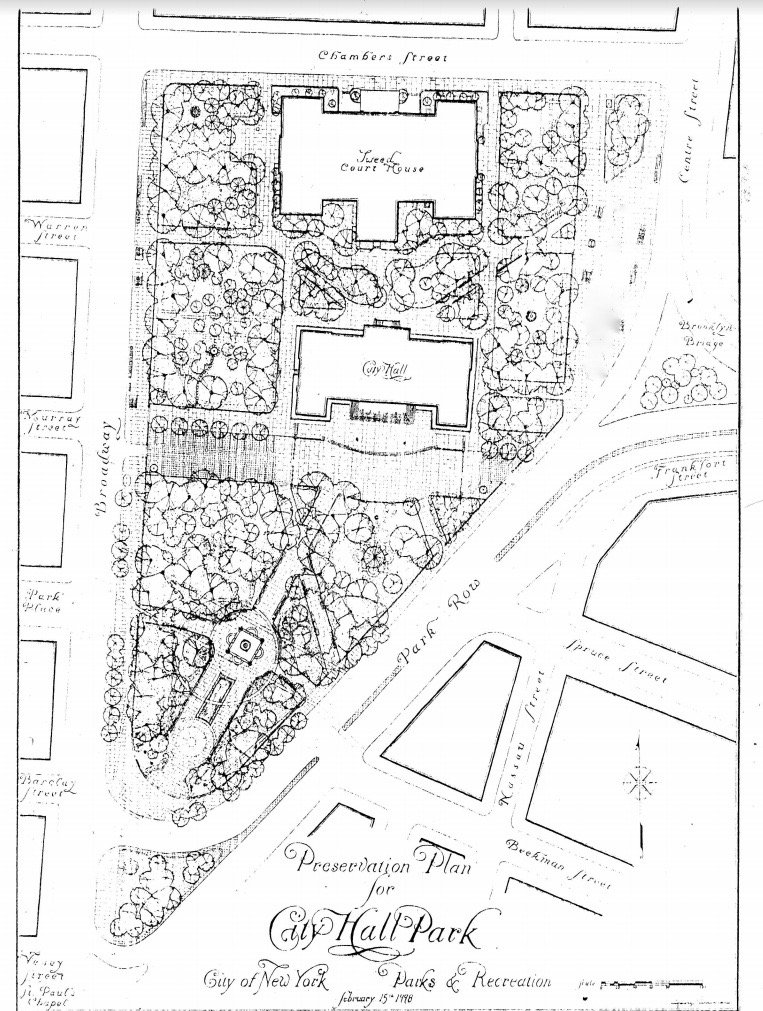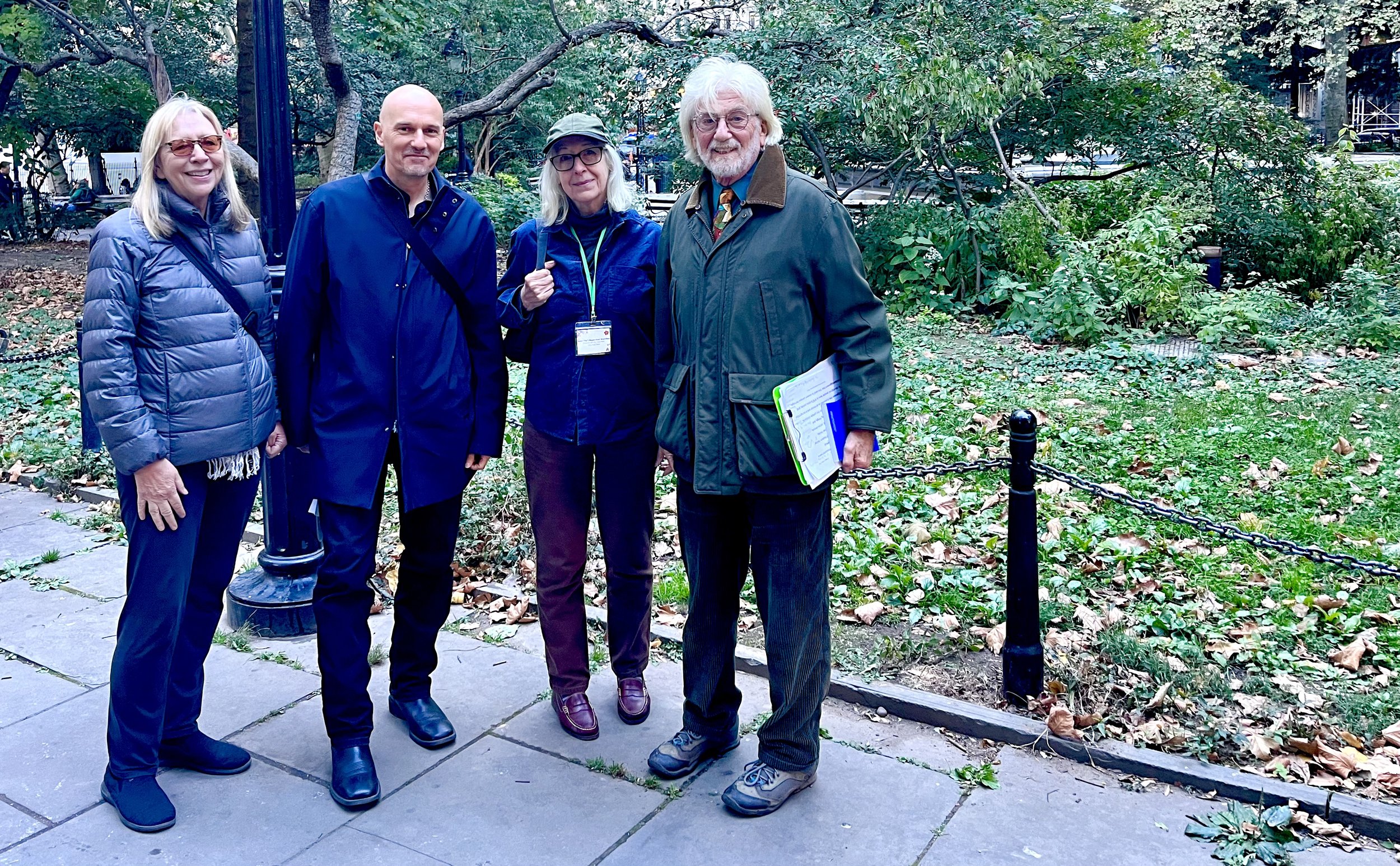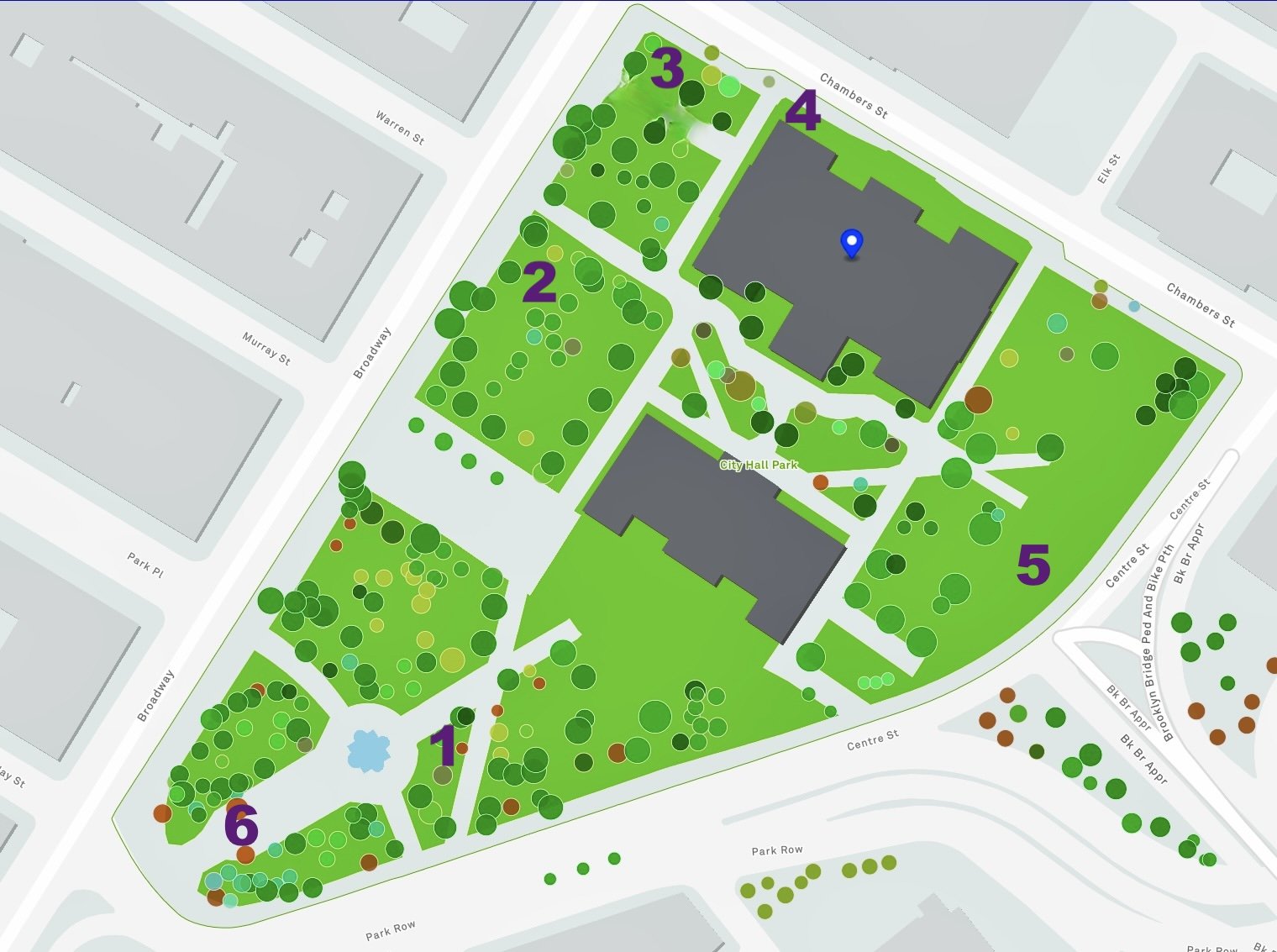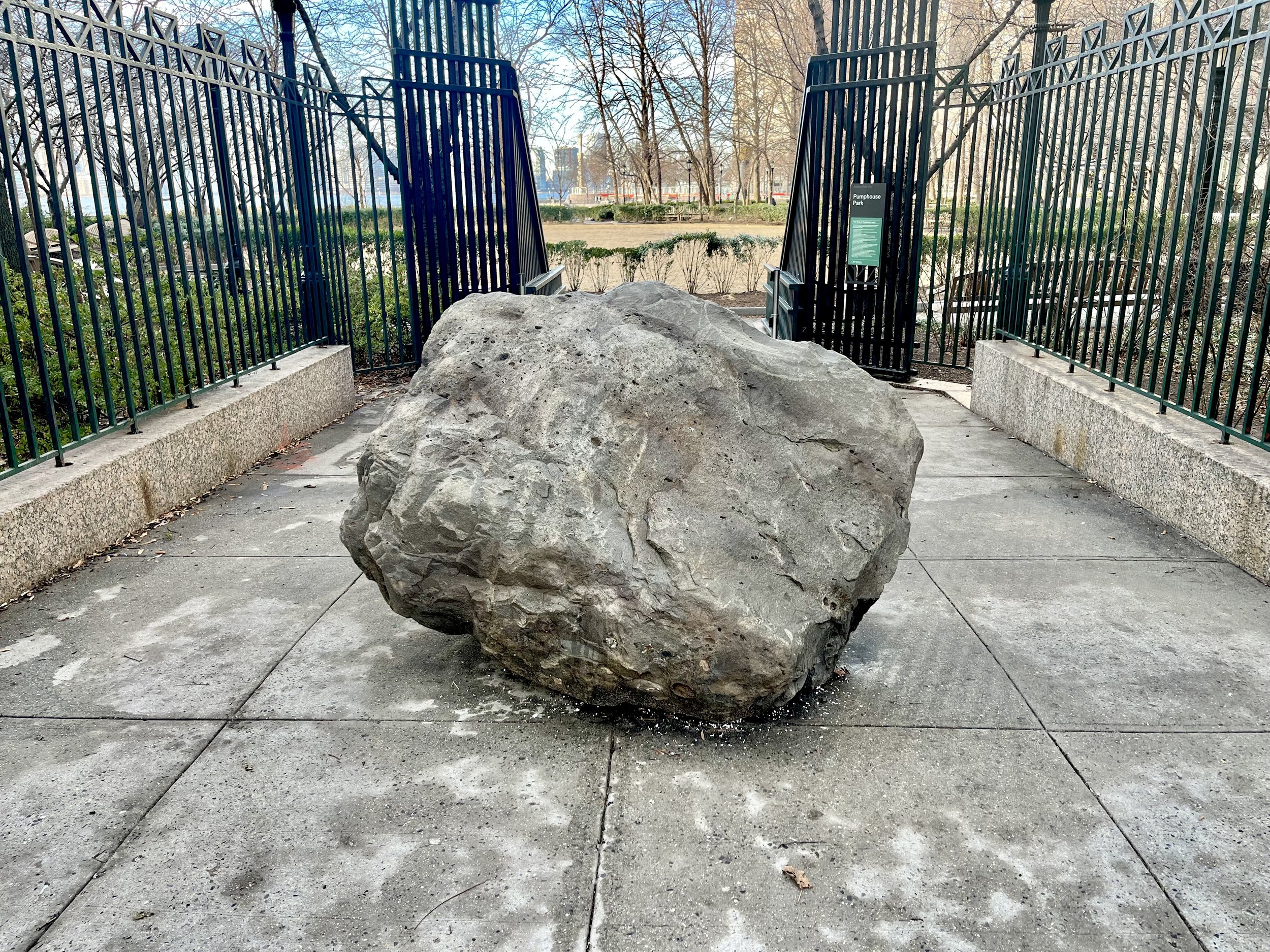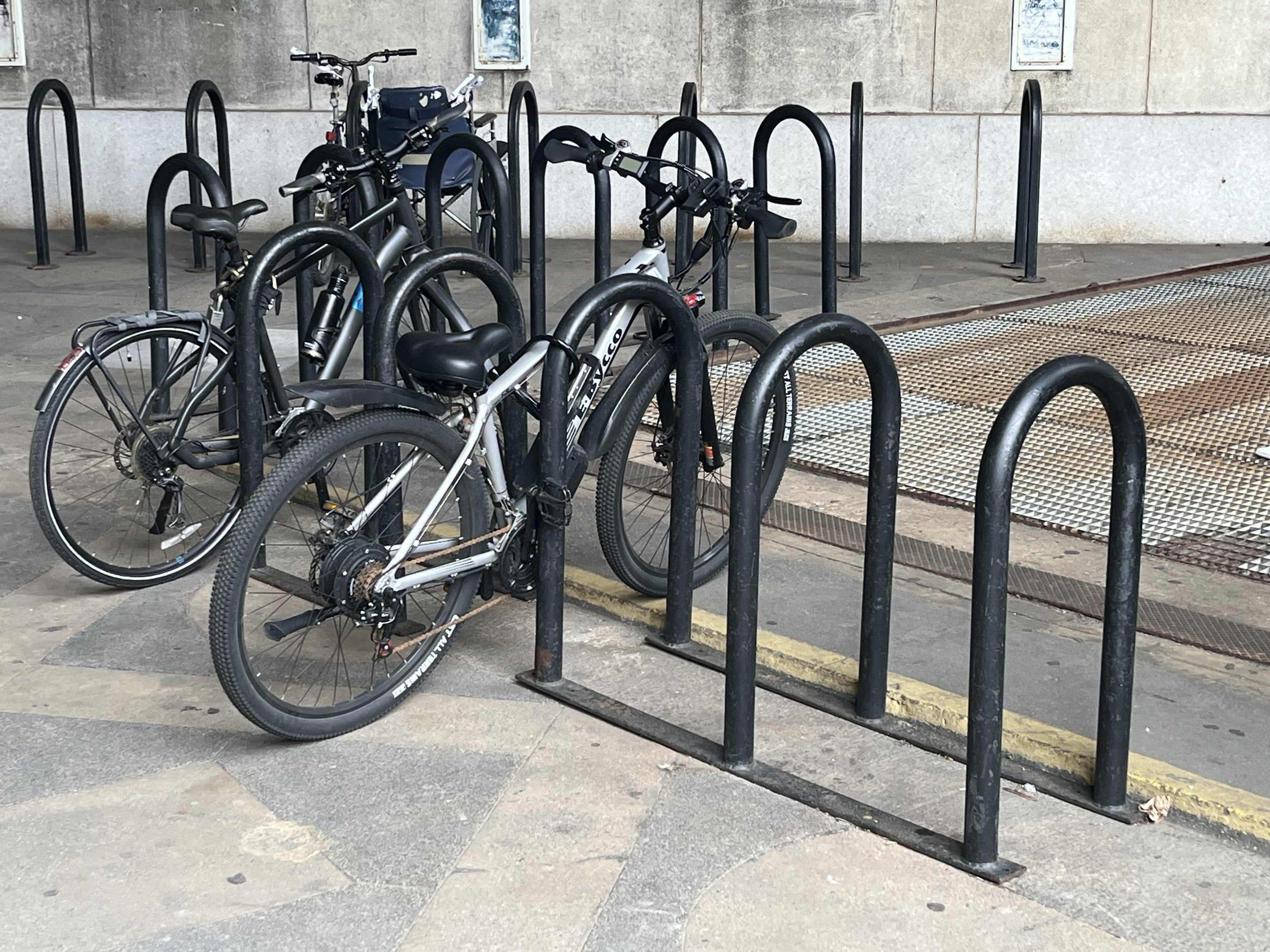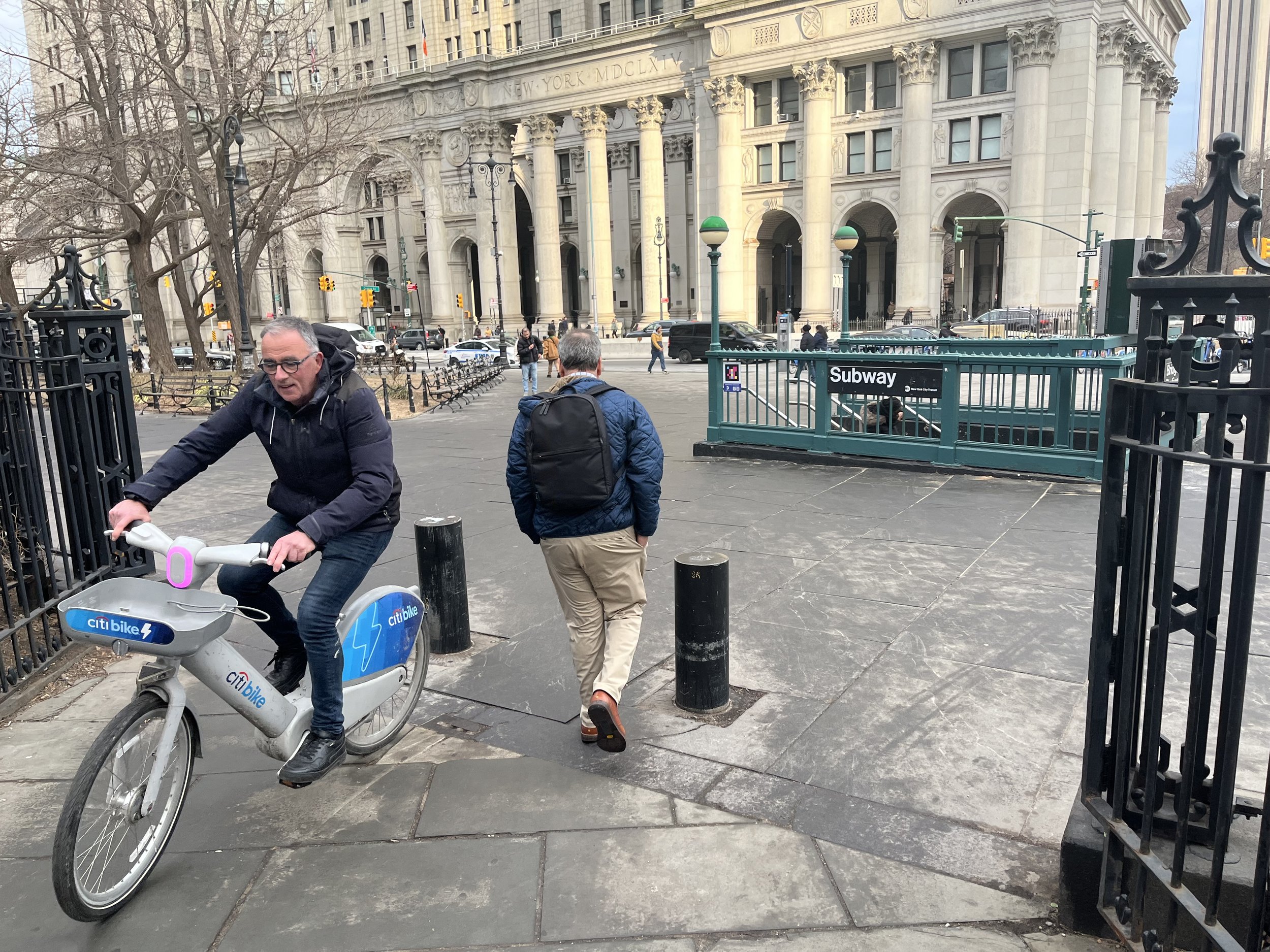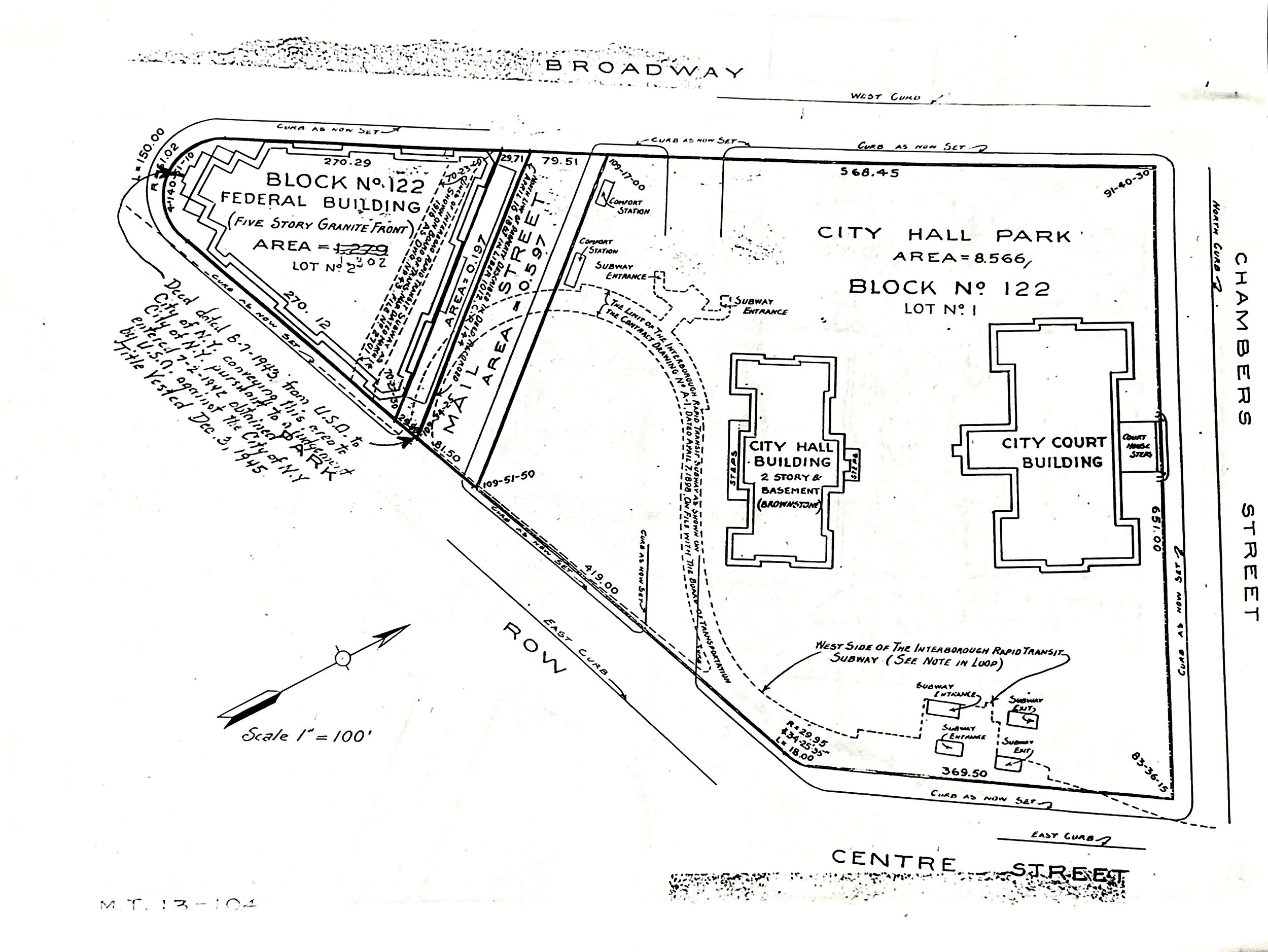Friends of City Hall Park Proposal in consultation with Lenape Center 6/19/2025
City Hall Park Northeast Plaza Renovation
~Lenapehoking Acknowledgement~
for CB1 street co-naming application: please scroll down pAST THIS PROPOSAL.
City Hall Park is NYC Parks’ administrative and physical space from curb to curb on the City Hall Park block, with shared use and responsibilities by DOT, MTA, Sanitation Department, DCAS, DoE, NYPD 1st and 5th Precincts, NYPD Municipal Security Section Intelligence Bureau, other city agencies, sub-contracted service vendors, official visitors and media.
FCHP’s (with Lenape Center consultation) proposed Northeast Plaza improvements are to reclaim the NYC Parks space:
• for desperately-needed, safe, more-peaceful recreation open space for residents, workers, shoppers. tourists, and all who pass by in the center of densely developed lower Manhattan,
• for respectful surroundings for New York City’s Mayor and City Council, other elected officials, and agencies’ staff in our civic center next to City Hall.
• for well-deserved recognition of Lenapehoking, in part to remedy omission in CHP history signage.
As lower Manhattan’s resident population continues to grow, we need more recreational and open spaces, including a quieter, more peaceful, more park-like Northeast Plaza.
For decades, City Hall Park’s Northeast Plaza, located in arguably the world’s most valuable real estate, has been an under-used open space, a very wide sidewalk, a remainder of the 2nd Avenue elevated train grand terminal (1878 - 1942).
In 2014 NYC Parks offered a permit to one food cart. Growing from there, particularly after the pandemic lockdown ended, the Brooklyn Bridge pedestrian walkway and the Northeast Plaza blossomed with commercial vendors.
The NYC Parks public space has become a congested, noisy, smokey, polluting, trash-spewing, unhealthy food court, with souvenir sales tables that evacuated from the Brooklyn Bridge, all products available within a block. The de facto market has grown to at least 12 and more than 20 vendors’ carts and tables on recent nice days. Who knows how many vendors will invade the wide open space this summer?
On busy days, crowds of shopping Brooklyn Bridge tourists plus subway and walking commuters create congested pedestrian traffic jams that impede free flow through the open space. The environmental intrusions of beef fat smoke, gas generator pollution and noise, several very loud music sources and littered food, paper and plastic cart waste continue even when there are no customers, no pedestrians at all on the plaza. (Please scroll down for photos).
Neither NYPD nor PEP has successfully enforced preventing the illegal, unsafe, annoying, out-of-control encroachment on NYC Parks land
On this same land, the Lenape people are ancient geographic forebears for all of us in our neighborhood, our city and our region. From some perspectives, we reside, work and play on their land. This proposal honors the First People, their modern descendants, and this place that is important in their and in our history, and currently.
Lenapehoking, translated as “Lenape homeland,” their nation extending from the upper Hudson Valley to the Chesapeake Bay, is centered here in lower Manhattan.
For thousands of years, this land has been the territory solely of the Lenape people, who were living here long before the arrival of Dutch-sponsored explorer Henry Hudson in 1609 and Dutch colonization beginning in 1624.
Overlay map of Werpoes, pond and nearby terrain with early 19th century street grid to City Hall. NE Plaza site is seen.
Lenape families lived in a year-round village where Duane, Thomas, and Worth Streets are now. (Please see Overlay map). Werpoes was southwest of a 6-acre, 60-foot-deep, spring-fed fresh-water pond, with wildlife and Lenape walking trails approximately where Broadway, Centre St and Park Row are.
At the beginning of colonization, the Lenape co-existed cooperatively with early settlers in the colony and in the forest, including engaging in trade with the profit-seeking Dutch East India Company.
The sale of Manhattan island by the Lenape, a transaction with no evidence, is a profound cultural misunderstanding continuing today. In the first 40 years of colonization, well-accepted history documents the genocide of many thousands of Lenape people, 90% of their population, as well as clear-cutting their villages, growing fields and forest habitat by Dutch and English settlers, then forced removal of the surviving Lenape to distant reservations by the early U.S. government.
This proposed renovation and acknowledgement provide well-deserved recognition in NYC’s civic center to the Lenape nation in order to contribute to achieving their rightful historic place, specifically remedying their omission in CHP’s NYC historical Time Wheel. It is a travesty that the official history of NYC written in stone in CHP begins with the Dutch, ignoring the first people here, short of a reference to Broadway’s origins as a Lenape trail! Fair compensation for the long-ago forcibly-taken land is not within the realm of this proposal, but this proposed plaza renovation and acknowledgement are fitting for this precious open space in lower Manhattan and for the earth underneath the pavement.
This proposed renovation is initiated by Friends of City Hall Park, a group of neighbors and New Yorkers city-wide since 1995, who use and love the park, and who volunteer to assist NYC Parks to make the best possible CHP, and to lobby for parks city-wide. FCHP collaborates on achieving this proposal with Lenape Center’s Joe Baker, Executive Director and Hadrien Coumans, Deputy Director.
Lenape acknowledgment and plaza renovation are proposed to be sponsored and supported by Councilmember Chris Marte, Mayor Eric Adams, NYS Senator Brian Kavanagh, NYS Assemblymember Deborah Glick, NY Congressmember Dan Goldman, and Community Board 1.
The proposal is facilitated at NYC Parks by Regional Parks Manager Terese Flores and Manhattan Commissioner Tricia Shimamura. Contact with DOT is Kate Scherer, DOT Lower Manhattan Planner. Contact with NYPD is NYPD Inspector Melody Robinson, Commanding Officer, Municipal Security Section, Intelligence Bureau and 1st Precinct Community Affairs Officer Nick Iordanou.
As a precaution against frequently speeding vehicles, potential vehicle accidents, random acts of violence, or planned terrorism, which have occurred frequently recently in pedestrian plazas internationally, a protective fence along Centre Street traffic lane curb is proposed; e.g. one simple, appropriate, effective solution is mirroring the tall curb and metal fence on the other side of Centre Street (Please see traffic fence photo). Citi-bike and proposed two added public bike racks provide needed protection. For added security, quieting the public space, and protecting the fragile, brittle, crumbling bluestone pavement, closing 3 of the plaza’s 6 entrances to vehicles with bollards, except for one plaza entrance for emergency and service vehicles access, is proposed.
With wide spaces between proposed park amenities and boulders allowing free pathways crossing the plaza to the 9 pedestrian entrances, none of the proposed plaza additions prevent pedestrians from entering, crossing or assembling for public performance or free speech expression.
Six new indigenous trees, with tags acknowledging the Lenape, were planted on four CHP sites on Arbor Day, 2025, with additional trees approved.
With the proposed, easily-installed park amenities, added City Hall and safe pedestrian security, repaired bluestones and MTA glass bricks, and meaningful acknowledgement elements, the proposed renovation inexpensively and expediently restores the NYC Parks recreational property, creates a respectful civic center, and is a permanent civic remembrance of the First People.
This proposed renovation represents a substantial acknowledgement of the importance of this place to the Lenape Nation and a recognition of the historic position of the Lenape people and the Lenape homeland by the NYC, NYS and U.S. governments, as well as by CB1 and neighborhood residents, businesses and workers. It communicates the important omitted history to the world, as well as sustains and nurtures community traditions and identity amongst the contemporary Lenape people. This project has potential to make a profoundly positive, lasting impact on the Lenape people, on our neighborhood, and on many of the thousands who pass through the plaza daily!
1 - 4. 4 sites with 6 amelanchier trees (donated by FCHP), tree tags and a proposed permanent plaque.
Lenapehoking in CHP
Acknowledgement in tree tags. Planted Arbor Day 2025.
Two saplings near central fountain (site 1)
NYC Parks commits to required two years stewardship for the trees planted Arbor Day, 2025, with FCHP’s volunteer assistance.
5. LENAPEHOKING Plaza Proposal
NE Plaza Renovation
Approximate drawing not to scale.
For NE Plaza historic photos: click History Gallery, then scroll down.
Chalk drawings of bollards, Boulders, benches, signs, tables:
Boulder in Battery Park City
5 Lenapehoking Boulders from rural upstate Lenapehoking territory. Provided by Lenape Center.
2 DOT street signs co-named “LENAPEHOKING (Lenape Homeland)” (Please scroll down for curren•t draft “CB1 Street Co-naming Application”).
NYC Parks historical signs - Brief text about the Boulders, plaza, Lenape, & Lenapehoking; illustration & map of forest land where CHP is; map of Lenapehoking region; historic photos of plaza, and other artwork; e.g. Collect Pond Park signs:
• Park amenities: 2 5-bike racks, 2 chess tables, 2 6-foot benches, 3 9-foot benches, and 6 9-foot backless benches (parallel to and about 4 feet from the CH fence).
• Vehicle protection security capital improvement: Add traffic fence and high curb along plaza’s Centre Street curb, new bollards at 3 plaza entrances.
• NYC Parks: Repair dangerous bluestone pavement (see photos below).
• MTA: Repair glass bricks, permanently cover, or replace; remove construction fence (Since summer 2020 obstructs pedestrian movement, attracts obscene graffiti, accumulates trash). (See photos below).
6. NYC Parks Plaque near Time Wheel
In “parterre” planting bed. Acknowledges Lenape history in the history of New York City, amending the nearby Time Wheel NYC history in stone:
“LENAPEHOKING (Lenape Homeland)
For thousands of years before New Amsterdam and New York, and continuing today, this very land is the Lenape homeland. Until genocide, clear cutting their villages, fields & sustaining forests, then forced removal, by the Dutch, English and then the U.S. government, the Lenape nation extended from the Hudson Valley to the Chesapeake Bay, with hundreds of thousands of the First People.”
Lenape village in Manhattan
“prior to the occupation by the Dutch”
Collect Pond-top right Werpoes village-top left
CHP site-bottom field
6/17/2025
CB1 Street Co-Naming Application
LENAPEHOKING Lenape Homeland Historic Place
Friends of City Hall Park in consultation with Lenape Center
Lenape people are ancient geographic forebears for all of us in our neighborhood.
Lower Manhattan before Dutch colonization was a forest, with fresh water, wildlife and Lenape trails and villages.
Co-name Sign Poles sites are near where the Lenape village Werpoes was.
Two co-name signs (circled in red) border City Hall Park’s Northeast Plaza. (
Scroll down for photos of poles.):
1. Centre St & Chambers St SW corner.
2. Centre St & Park Row intersection corner.
Co-name within a block: Black Lives Matter Boulevard, diagonally across from requested pole 1.
Nearest border to historic African-American Burial Ground Monument is more than a block away. The Monument and original complete burial ground borders are located within Lenapehoking and on the Lenape Werpoes village site.
Manhattan Community Board 1’s jurisdiction district has been the homeland of the Lenape people for thousands of years, continuing today with Lenape Center’s office, coincidently, on Vesey Street near Broadway. From some perspectives, we reside, work and play on Lenape land.
This proposal honors the First People, their modern descendants, and this place that is important in their and in our history, and currently.
The Lenape people are ancient geographic forebears for all of us in our neighborhood, our city and our region. From some perspectives, we reside, work and play on their land. This proposal honors the First People, their modern descendants, and this place that is important in their and in our history, and currently.
Lenapehoking, translated as “Lenape homeland,” their nation extending from the upper Hudson Valley to the Chesapeake Bay, is centered here in lower Manhattan.
For thousands of years, this land has been the territory solely of the Lenape people, who were living here long before the arrival of Dutch-sponsored explorer Henry Hudson in 1609 and Dutch colonization beginning in 1624
Lenape families lived in a year-round village where Duane, Thomas, and Worth Streets are now. Werpoes was southwest of a 6-acre, 60-foot-deep, spring-fed fresh-water pond, with wildlife and Lenape walking trails approximately where Broadway, Centre St and Park Row are.
At the beginning of colonization, the Lenape co-existed cooperatively with early settlers in the colony and in the forest, including as trading partners.
The sale of Manhattan island by the Lenape is a profound cultural misunderstanding at the time and continuing today. In the first 40 years of colonization, well-accepted history documents the genocide of hundreds of thousands of Lenape people, as well as clear-cutting their villages, growing fields and forest habitat by Dutch and English settlers, then forced removal of the surviving Lenape to distant reservations by the early U.S. government.
It is a travesty that the official history of NYC written in stone in CHP begins with the Dutch, ignoring the first people here, short of a reference to Broadway’s origins as a Lenape trail! Fair compensation for the long-ago forcibly-taken land is not within the realm of this proposal, but this proposed street co-signing is fitting for this precious open space in lower Manhattan and for the earth underneath the pavement.
This proposed street co-signing provides a substantial acknowledgement of the importance of this place to the Lenape Nation and a recognition of the historic position of the Lenape people and the Lenape homeland by the NYC, NYS and U.S. governments, as well as by CB1 and neighborhood residents, businesses and workers. It communicates in our civic center the important omitted history to the world, as well as sustains and nurtures community traditions and identity amongst the contemporary Lenape people.
The history of the Lenape people in this place is significant and culturally important to the the Lenape people and Lenape Nation, to New York City, and to the United States, albeit almost totally ignored in published and taught histories.
This project has potential to make a profoundly positive, lasting impact on the Lenape people, on our neighborhood, and on many of the thousands who pass through the plaza daily!
Lenape Center and cohort are the leading experts on Lenape Culture, with frequent academic and cultural presentations, including as Visiting Professor at Colorado College and Columbia University.
Lenape Center’s Lenapehoking; An Anthology, (edited by Joe Baker, Hadrien Coumans & Joel Whitney, Brooklyn Public Library, 2023) is a powerful collection of well-written short essays and poems that tell the real story.
There are other well-received books covering the Lenape homeland that you might know, like The Island at the Center of the World (Russell Shorto, Vintage Books, 2006) and Mannahatta (Eric Sanderson, Illustrated by Markley Boyer, Abrams, 2009), many feature and documentary films, and TV shows, few that are totally accurate, many outrageously inaccurate.
It is a travesty that the official history of NYC written in stone in CHP begins with the Dutch, ignoring the first people here, short of a reference to Broadway’s origins as a Lenape trail! Fair compensation for the long-ago forcibly-taken land is not possible, but this proposed co-naming is fitting for this open space in lower Manhattan and the earth underneath the pavement.
This proposed co-naming represents a substantial acknowledgement of the importance of this place to the Lenape Nation and a recognition of the historic position of the Lenape people by the NYC government, as well as by CB1 and neighborhood residents, businesses and workers. It communicates the important omitted history to the world, as well as sustains and nurtures community traditions and identity amongst the contemporary Lenape people. This project has potential to make a profoundly positive, lasting impact on the Lenape people, on our neighborhood, and on many of the thousands who pass through the plaza daily!
This proposal is initiated by Friends of City Hall Park, 30-year-old community group of neighbors and NYers’ city-wide, who use and love the park; who volunteer to assist NYC Parks’ care for the 6 acres of publicly-accessible lawns and paths; who work with City Hall, NYPD and NYC Parks to assure and expand public access; and who lobby for adequate NYC Parks funding with the Play Fair coalition, and for urban forest development city-wide with Forest for All NYC.
FCHP collaborates on achieving this proposal with Lenape Center’s Joe Baker, Executive Director and Hadrien Coumans, Deputy Director.
The proposal is supported by City Hall Park Conservancy (pending), CM Marte and NYS Senator Kavanagh, and is facilitated at DPR by Regional Parks Manager Terese Flores and Manhattan Commissioner Tricia Shimamura. Contact with DOT is Kate Scherer, DOT Lower Manhattan Planner. Requests for support have been extended to US Congressmember Dan Goldman and NYS Assemblymember Deborah Glick.
Subway station & tunnel / street level overlay map
FOR RENOVATION PROPOSAL REFERENCE.
